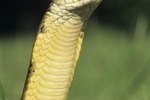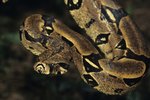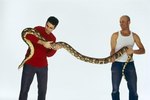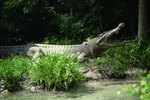
Although most snakes, turtles, lizards and other reptiles typically pose little threat to humans, some can be numbered among the deadliest creatures on the planet. The most dangerous among them can be determined by evaluating data from zoos, animal researchers and other scientific sources.
Alligator Snapping Turtle
While turtles are mostly harmless, these 2-foot-long turtles weigh more than many humans -- males can weigh as much as 220 pounds -- and have strong jaws that can amputate the fingers or limbs of anyone who gets too close.
Reticulated Python

Found throughout southeast Asia, the reticulated python can weight more than 350 pounds and reach lengths of 30 feet. The snake's size matters because it kills by constriction so its mass literally squeezes victims to death by suffocation.
Fer-de-Lance
This pit viper found throughout Central and South America is not only venomous but highly aggressive. While most snakes bite only once to conserve their venom, the fer-de-lance will strike multiple times. According to the BBC, half of all bites in Costa Rica are delivered by this large reptile.
Eastern Brown Snake
Australia holds the distinction for being home to the most types of venomous snakes, with more than 50 species. However, more than three-fourths of all snakebites on the continent are delivered by the eastern brown snake. Although its venom is deadly and can cause paralysis within minutes, improved anti-venom availability means this snake kills only one or two people every year.
Black Mamba
What makes the black mamba so dangerous is not just its powerful venom. The snake is also fast: it can slither at a rate of more than 12 miles per hour, meaning it can outrun most humans. Another dangerous aspect of this snake is its location. Most humans encounter black mambas in rural areas of Africa, so reaching anti-venom and medical treatment in time is not always possible. Without treatment, the black mamba's poison is fatal within 20 minutes.
Komodo Dragon

New research has shown the Komodo dragon does not kill its prey with bacterial infections. Instead, these large land lizards from Indonesia have special serrated teeth that not only tear at a prey's flesh but inject venom into the victim as well. This combination makes the Komodo dragon a lethal reptile capable of killing large animals, even humans.
Taipan
Taipans are a group of snake species native to Australia. All of them are large, fast-moving and extremely dangerous. One bite from a coastal taipan contains enough venom to kill 12,000 guinea pigs. The western taipan injects venom that causes effects including hemorrhaging, tissue and muscle damage, and muscle paralysis.
King Cobra

Found in parts of Asia, the king cobra does not produce highly toxic venom. Instead, this massive snake, which can grow to 18 feet in length, produces a lot of venom. In one bite, a king cobra can deliver enough toxic juice to kill 20 people. According to National Geographic, these snakes can fill up one-fourth of a shot glass with venom if their glands are pumped.
Asian Cobra

As the name suggests, this cobra is common throughout Asia, including large parts of India and China. In these areas, snakebites are more common than in other parts of the world and cause large numbers of fatalities. Every year, India has more than 50,000 deaths caused by venomous snakes, and most are the work of the Asian cobra.
Crocodile

Although poisonous snakes are deadly, the crocodile kills with sheer strength. Every year, 800 people are killed by crocodiles. Although they seem slow and clumsy, they are expert stealth hunters with strong jaws and powerful bodies. A study reported by National Geographic found saltwater crocodiles, which are the largest in size, can exert up to 3,700 pounds of pressure per square inch on anything caught in their jaws.
References
- National Georgraphic: Alligator Snapping Turtle
- Australian Geographic: Australia's 10 Most Dangerous Snakes
- Epoch Times: 10 Deadliest Animals in the World
- Reptile Gardens: World's Deadliest Snakes
- National Geographic: World's Deadlist Snakes Facts
- Encyclopedia Britannica: 8 of the World's Deadliest Snakes
- Environmental Graffiti: Komodo Dragon
- Live Science: Top 10 Deadliest Animals
- Reptile Park: Asian Cobra
- National Geographic: Black Mamba
Resources
- Animal Diversity Web: Reticulated Python
- BBC: Fer-de-Lance
- Reptile Park: Eastern Brown Snake
- National Geographic: Komodo Dragon
- Science Daily: Komodo Dragons Even More Deadly Than Thought: Combined Tooth-Venom Arsenal Key To Hunting Strategy
- National Geographic: King Cobra
- National Geographic Daily News: Crocodiles Have Strongest Bite Ever Measured
Photo Credits
-
Comstock/Comstock/Getty Images
Writer Bio
Amy Jorgensen has ghostwritten more than 100 articles and books on raising and training animals. She is also an amateur dog trainer. She has also written more than 200 blog posts, articles, and ebooks on wedding and party planning on behalf of professionals in the field.




